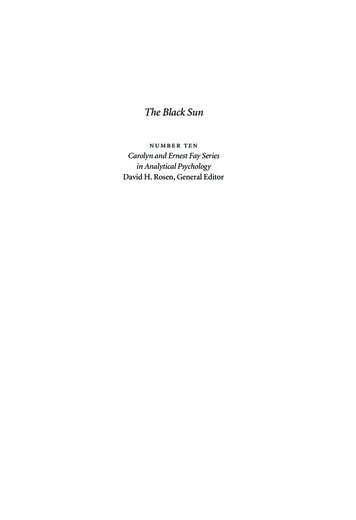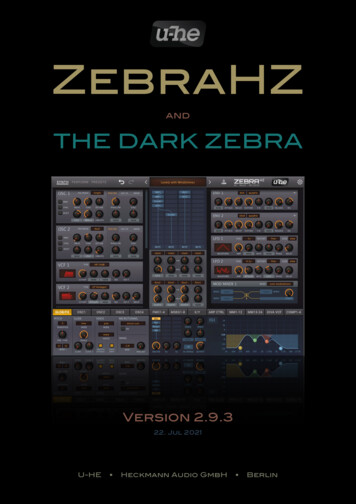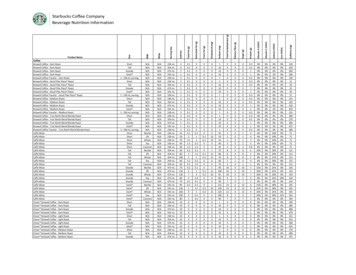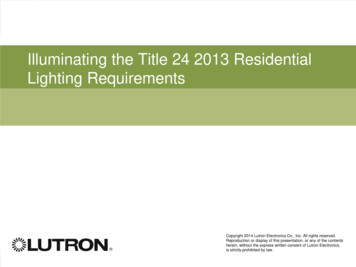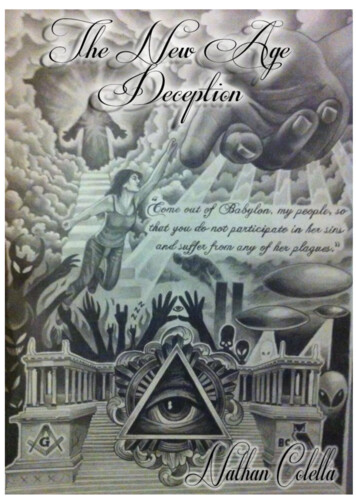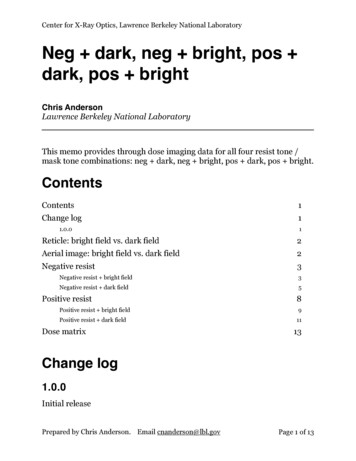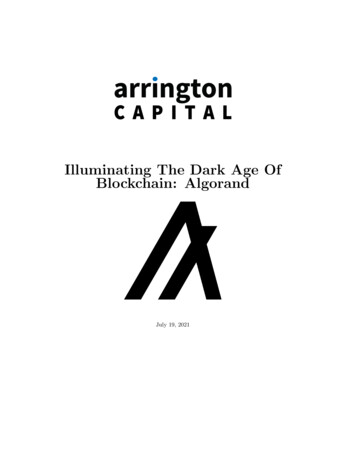
Transcription
Illuminating The Dark Age OfBlockchain: AlgorandJuly 19, 2021
John Trumbull’s Declaration of Independence (1819). TheBirth of the Republic of the United States.The Enlightenment culminated in the birth of the American Republic, a revolutionary systemfor coordinating society – for reaching consensus.It redefined the relationship between rules and rulers, introducing the novel idea of selfgovernment – where the users and securers of the network are the same.1
DisclosureArrington Capital and/or its affiliates (collectively “Arrington Capital”) has a financial interest in thesuccess of the Algorand Ecosystem, including affiliated ecosystems, initiatives and projects (collectively“Algorand Ecosystem”). Arrington Capital currently owns ALGO tokens.As of the publication date of this report, Arrington Capital, others that contributed to this report, andthose that we have directly shared our research with, are supporters of the Algorand Ecosystem and standto realize the gains through various manners of participation. All content in this report represent theopinions of Arrington Capital. Arrington Capital has obtained all information herein from third-partysources they believe to be accurate and reliable, including Algorand Ecosystem. Third-party sources maynot have been independently verified and its accuracy or completeness cannot be guaranteed and not berelied upon as such. Information is presented “as is”, without warranty of any kind – whether express orimplied.This document is for informational purposes only and is not intended as an official recommendation orconfirmation of any transaction. The information contained herein does not take into account the particular investment objectives, regulatory status or financial circumstances of any specific person who mayreceive it. All market prices, data and other information are not warranted as to completeness or accuracy,are based upon selected public market data, and reflect prevailing conditions and Arrington Capital’sviews as of this date, all of which are accordingly subject to change without notice. Arrington Capital hasno obligation to continue offering reports regarding the project. Reports are prepared as of the date(s)indicated and may become unreliable because of subsequent market or economic circumstances.Any investment involves substantial risks, including, but not limited to, pricing volatility, inadequateliquidity, and the potential complete loss of principal. This report’s estimated fundamental value onlyrepresents a best efforts estimate of the potential fundamental valuation of a specific token, and is notexpressed as, or implied as, assessments of the quality of a token, a summary of past performance, or anactionable investment strategy for an investor.This document does not in any way constitute an offer or solicitation of an offer to buy or sell anyinvestment or token discussed herein.The information contained in this document may include, or incorporate by reference, forward-lookingstatements, which would include any statements that are not statements of historical fact. These forwardlooking statements may turn out to be wrong and can be affected by inaccurate assumptions or by knownor unknown risks, uncertainties and other factors, most of which are beyond Arrington Capital’s control.Investors should conduct independent due diligence, with assistance from professional financial, legal andtax experts, on all tokens discussed in this document and develop a stand-alone judgment of the relevantmarkets prior to making any investment decision.By accepting this information the recipient agrees and acknowledges that no duty is owed to the recipient by Arrington Capital. The recipient expressly waives any claims arising out of the delivery of theinformation or the recipients use thereof or reliance thereon.2
Executive SummaryIn this paper, we argue that blockchains are trapped in a dark age of technology centralization. Thewars of multi-chain DeFi push the market to abandon decentralization, its oldest and most foundationalprinciple. Crypto’s citizens search for “fast” technologies that optimize for DeFi yield generation, evenif this hands power to a new class of kingmakers – from centralized exchange operators to politicalfigureheads who guide the destiny of these networks.This dark age presents users with a choice: performance or decentralization, but not both. Following onfrom our 2019 report1 at the launch of MainNet, we argue that Algorand represents an opportunity totranscend this paradigm. It is the first “fast L1” which can coordinate between billions of people withouttrending toward plutocracy. Consensus is fast yet open to anyone: Algorand currently performs 1,000TPS with 5 second finality without sacrificing decentralization.Solving the “blockchain trilemma” compromising other networks, Algorand has been live for two yearswith no downtime. A series of novel cryptographic and political breakthroughs create a new systemof self-government and evolvability unlike any other L1 blockchain. The end result: a way forward forDeFi without forsaking decentralization and a ground-up network for risk-averse TradFi applications likeCentral Bank Digital Currencies (CBDCs) and asset securitization.If the Enlightenment – an 18th century intellectual movement focused on the ideals of reason, libertyand constitutional government – was humanity’s new base layer protocol, then the scientific method andindustrial revolution were simply the apps that followed.What apps could emerge in an Algorand age of reason? One simple application is “fast DeFi” withoutcentralization and inefficiencies like miner extractable value (MEV). Another application – arguably theultimate goal – is the eventual merger of DeFi and TradFi. We could see a wave of hybrid experimentswhere DeFi plugs into TradFi, bridging old and new capital pools.This, perhaps, is crypto’s industrial revolution – a productivity boom that will come long after the endof the DeFi wars. In our view, Algorand could be the immutable home of high-value assets, where hybridexperiments emerge and grow to global scale.1 -monetary-experiment-algorand/.3
ContentsDisclosure2Executive Summary3Introduction61 The1.11.21.31.41.5Algorand ThesisThe Barbarians Of DeFi . . . . . . . . . .Can We Escape The War Of Pragmatism?Marrying Old & New Pools Of Capital . .The Promise Of ETH 2.0, Today . . . . .Moving Past The Dark Age . . . . . . . .778810112 The Science Of Algorand2.1 Context: The Long Chain Of Cryptographers . . . . . . . . . . . . . . .2.1.1 The Byzantine Generals Problem (BGP) . . . . . . . . . . . . . .2.1.2 Two Answers & The Blockchain Trilemma . . . . . . . . . . . . .2.2 Algorand Design Philosophy . . . . . . . . . . . . . . . . . . . . . . . . .2.2.1 Do Not Do As The Romans: A Forkless Empire . . . . . . . . .2.2.2 Consensus: Easy To Reach, Difficult To Subvert . . . . . . . . .2.3 Until The End Of Time: Secured By Randomness . . . . . . . . . . . .2.3.1 The Alchemy Of Algorand: Verifiable Random Functions . . . .2.3.2 Selecting Random Committees: Sortition At Work . . . . . . . .2.3.3 One Microsecond & The Age Of The Universe . . . . . . . . . .2.3.4 The Separation Of Powers . . . . . . . . . . . . . . . . . . . . . .2.3.5 Fast, Final & Yet Also Secure: Fortifying Algorand . . . . . . . .2.4 The Politics Of Algorand . . . . . . . . . . . . . . . . . . . . . . . . . .2.4.1 Blockchains Are Political Animals . . . . . . . . . . . . . . . . .2.4.2 Political Systems Face The Trilemma . . . . . . . . . . . . . . .2.4.3 The Market Is Underweighting Decentralization . . . . . . . . . .2.4.4 The Inevitable Aristocracy: Four Critiques Of Modern PoS . . .2.4.5 The Politics Of Algorand: PPoS . . . . . . . . . . . . . . . . . .2.4.6 The American Experiment Versus The Algorand Experiment . .2.5 Algorand’s Unconstrained Stack . . . . . . . . . . . . . . . . . . . . . . .2.5.1 Algorand Primitives . . . . . . . . . . . . . . . . . . . . . . . . .2.5.2 Upcoming Roadmap: 46k TPS & Smart Contract Composability2.5.3 An ESG Network . . . . . . . . . . . . . . . . . . . . . . . . . . 262626292929.3 The Marriage of DeFi & TradFi3.1 Algorand DeFi: The Return Of The L1 Maximalist . . . . . . . . . . . . . . . .3.1.1 Build Now, Fix Later: The Hidden Danger Of Silicon Valley “Iteration”3.1.2 Algorand: DeFi Without Tradeoffs (Or MEV) . . . . . . . . . . . . . .3.2 Onboarding The Old World: TradFi Use Cases . . . . . . . . . . . . . . . . . .3.2.1 CBDCs: The Next Phase Of Fiat . . . . . . . . . . . . . . . . . . . . . . . . . .4
3.33.2.2 Global Payment Rails . . . . . . . . . . . . . . . . . . . . .3.2.3 STOs & Asset Tokenization: The New Capital Markets . .Algorand’s Hybrid Experiments . . . . . . . . . . . . . . . . . . . .3.3.1 Increasing Capital Efficiency Through KYC . . . . . . . . .3.3.2 Democratizing Credit Rating: Undercollateralized Lending3.3.3 Central Bank Yield Aggregators . . . . . . . . . . . . . . .3.3.4 Marrying Old & New Currency Markets . . . . . . . . . . .3.3.5 Bringing Sovereign Debt To DeFi . . . . . . . . . . . . . . .3.3.6 The Evolution Of On-Chain Equity . . . . . . . . . . . . .3.3.7 Connecting The Farmers & The Suits . . . . . . . . . . . .333334343536363737374 Risks38Conclusion395
IntroductionThe DeFi wars have forced new values into crypto. In the same way pre-Enlightenment masses blindlyaccepted the “benevolent monarch”, crypto embraces a new centralized royalty. Citizens choose mysticismover reason, assured not by ground-up constitutions, but by blessings of the elite and their carrots oftemporary yield.One core thesis underlies this report: today’s market is underweighting decentralization. The race for TotalValue Locked (TVL) is forcing tradeoffs unacceptable just a year ago. Hardline decentralists surrenderto a new, highly pragmatic ideology. With this new philosophy, the market quietly abandons L1 scalingambitions and concedes to two new forces: multi-chain centralization and L2 as the new panacea for DeFiscalability.Algorand represents an opportunity to transcend this rise of blockchain pragmatism. It is the first L1to break tradeoffs between performance, decentralization and security, offering a path forward for “fastDeFi” without giving up on crypto’s oldest and most utopian ideal.This is rooted in several scientific and political breakthroughs. Algorand leverages randomness to solveone of the hardest problems in distributed systems: how to not only build a fast system, but one that issecured by an open and boundless set of validators. Algorand consensus is as much a political breakthroughas it is a technical one, transcending contemporary paradigms for Proof-of-Stake (PoS).We recast the idea of the “blockchain trilemma” as a political trilemma. Blockchains face the same set oftradeoffs as any nation or government. The Algorand network breaks these confines and builds a systemof government where our rulers are not the chosen few, but the entire network. Consensus is for thenetwork, by the network, akin to the American ideal of self-government. Anyone can become a validator,governed by the same cryptographic lottery.Resulting from these breakthroughs, we believe Algorand’s positioning is twofold. It will benefit fromthe increased fragility of centralized blockchains. Every blowup that stems from network centralization –every coup, revolution and invasion – will make Algorand decentralization more attractive. At the sametime, the network’s assurances will attract TradFi capital unable to deploy on riskier networks. The endgame could be a series of hybrid experiments merging these parallel worlds – a new playground for DeFito incorporate a real-world asset base and TradFi to take advantage of crypto’s global liquidity.6
1The Algorand Thesis1.1The Barbarians Of DeFiThe DeFi wars gave birth to a new regime of blockchain pragmatism. Wounded by the eternal promiseof L1 scaling2 , the market waved a white flag to new invaders, the multi-chain maximalists. This was anew force that past utopians would decry as barbarian and unprincipled. It is also, we argue, the forcethat now holds power. The barbarians did not just breach the gates of DeFi yield – they reshaped thephilosophical destiny of most blockchains.With each battle, the nuances of L1 and L2 scaling3 mattered less, overshadowed by the market’s huntfor yield. Capital flocked to “fast L1s” and a cornered Ethereum community mounted its counterattack,L2. The market became increasingly blind to tradeoffs, migrating anywhere so long as it was free frombase layer congestion.How did decentralization lose so much ground? It starts with Binance Smart Chain (BSC). The rise ofBSC was 2021’s unexpected catalyst, yet it was arguably brewing for years. The failure of L1 scalingefforts which preserved decentralization left the decentralists vulnerable to attack. BSC taught us twothings: (1) Most users do not care about utopianism and (2) If under enough pressure, even the old guard– the hardline decentralists – would slowly cave to blockchain pragmatism.Figure 1: High gas fees on Ethereum and the commensurate growing activity on BSC. Users seeking asimilar but cheaper experience were forced to compromise between scalability and decentralization.Data from Messari 4 .To gauge the state of blockchains, consider how much L2 debates have morphed over the last year.There was once a time when L2 was a cautious debate centered on decentralization tradeoffs. Today,it is Ethereum DeFi’s panacea. A “build now, fix later” mentality supersedes the caution of earlycommunities. This shift is logical: absent L1 scaling, how can Ethereum defend its citiesfrom the barbarian takeover?2 Wedefine L1 scaling as attempts to increase throughput on a blockchain’s protocol layer.L2, transactions happen off-chain, but are usually settled on-chain.4 url: www.messari.com.3 In7
Stepping back from the DeFi wars, we pose a different question: is most of the world’s capital going tolive on technology shaped by 2021’s mercenary DeFi? Can these reactionary systems become the rails ofglobal finance beyond the insular needs of 2021 crypto?Figure 2: The rise of L1 bridges and L2 scaling solutions in response to high gas fees on Ethereum.Data from The Block 5 .1.2Can We Escape The War Of Pragmatism?Our core thesis is that today’s market is overestimating the value of blockchain pragmatism and underpricing the long term necessity of decentralization. Systems forged by multi-chain DeFi accept tradeoffsthat eventually limit their growth. Most of finance is not mercenary. Most of the world’s capital doesnot live inside a self-referential fight for yield.It lives in the land of risk-aversion. The old world will view decentralization like insurance: the marketwill ignore and underprice insurance until it really needs it.We think the decentralists are correct, but early. It is tempting to be drawn into the initial permutationsof a new technology and today’s market is no exception. The war of centralized blockchains could be likethe early Darwinism of the Internet.Every blockchain that must choose between decentralization and performance faces a fundamental paradox. Fast but centralized chains support global-scale applications, but their growth becomes a bountyfor network attacks, the mother of all rug pulls. Can institutions bring capital to a blockchainwhose success incentivizes its own demise? Conversely, if a system is decentralized but slow, itcannot support scalable applications to begin with.In the end, we need a system to break free from these limitations. That system, we argue, is Algorand.1.3Marrying Old & New Pools Of CapitalWhat would transcending these tradeoffs make possible? We argue that it dramatically widens the sizeof crypto’s available capital base. Escaping the confines of pragmatism is how we ultimately marry old5 url:https://www.theblockcrypto.com/.8
FDeowClSentiralizationsFatFDeiFigure 3: Algorand’s design is orthogonal to the design of current blockchains; it enables scalabilitywithout sacrificing decentralization.and new pools of capital and introduce DeFi to TradFi.This is Algorand. The network is positioned differently to other L1s. It takes a roundabout approach togrowing TVL. The Algorand path is multi-stage, focused on growing all of crypto TVL rather than feudingover today’s relatively limited and mercenary capital. The first and foundational move is technological:note that not only does Algorand escape tradeoffs, it has demonstrated this capability for two years inthe wild with no downtime. Can any L1 claim to solve base layer scalability (without collateraldamage), let alone prove a solution for two uninterrupted years?Quantifying a DeFi protocol’s TVL is straightforward. How can we price the value of network-levelassurances and their eventual ability to attract and maintain long term capital?This foundation positions Algorand to marry old and new pools of liquidity. We think of the Algorandnetwork as a call option on three main ideas: (1) Rebuilding DeFi without giving up L1 maximalism, (2)TradFi searching for a ground-up blockchain of assurances and (3) The interaction of legacy capital withcrypto-native liquidity.We sketch out some ideas for these hybrid experiments in the final section. These experiments are akinto the industrial and scientific boom (the apps) that followed the Enlightenment (humanity’s new baselayer). They move beyond the insular age: TradFi assets and yield plug into DeFi and become cryptocollateral, giving the old world access to globalized liquidity and the mercenary world an opportunity todiversify its farms into the real economy.9
ent railsAssetsecuritizationFigure 4: Algorand bridges DeFi and TradFi, spawning new hybrid experiments in capital markets.1.4The Promise Of ETH 2.0, TodayBefore the DeFi wars, the market focused on ETH 2.0 and the aspirations of L1 scaling6 . We remainstrong believers in the need for a strong L1 and think Algorand breathes fresh life into a forgotten cohort,the base layer maximalist.Stepping back, what was the promise of ETH 2.0? A base layer that is scalable, secure and decentralized.In its purest form, that’s Algorand, without ETH 2.0’s forward-looking risks. One does not need to waitfor ETH 2.0 to realize L1 ambitions – and for reasons we explore in the next section, Algorand’s uniqueapproach to PoS could actually be significantly more decentralized than ETH 2.0’s bonded PoS.Think of how this first-mover advantage could play out in the next few years. Even if ETH 2.0 goeslive by earliest projections, some capital will “wait and see” to assess the new network in the wild. Theclock restarts. Being the first to escape tradeoffs before ETH 2.0 carries significant advantages thatcan grow even after ETH 2.0.The credibility of public networks will scale like a nation’s rule of law. Capital will migrate to chainsthat demonstrate the longevity of their political system. Immigrants do not just want the promiseof the rule of law, they want a history to prove it.Let’s assume that institutions deploy structured products or that nations deploy CBDCs within the nextfive years. Realistically, where can they do it outside of Algorand? If we’ve established that they cannotdo it on systems constrained by blockchain pragmatism – and that they need systems with some degreeof Lindy – what are their options?It is hard to find a solution as “de-risked” as Algorand.6 .html.10
Lindy201920222023TimeFigure 5: Algorand’s Lindy effect: As the first to solve the trilemma, the Algorand network could gaincredibility exponentially over coming years, while ETH 2.0 (contingent on launch date) must inevitably“restart the clock”, particularly for risk-averse capital.1.5Moving Past The Dark AgeAlgorand rises above the war of tradeoffs and shatters the dichotomy between blockchain pragmatism anddecentralization. It leaves behind the dark age of technology centralization, offering both a fortress for“fast DeFi” and a bridge to risk-averse TradFi. Algorand ultimately moves past the DeFi wars, steppingback from the invasions and coups of multi-chain pragmatism to instead focus on the next decade offinancial deployments – on the next age of reason.11
2The Science Of AlgorandAlgorand makes a bold claim. If true, then it is L1 utopianism under the market’s nose. In this section,we explore the scientific foundation of Algorand, unpacking the breakthroughs that allow the protocol toscale while staying decentralized.2.1Context: The Long Chain Of CryptographersScientists face a paradox: they rarely live long enough to see their ideas gain recognition, let aloneadoption. With its speed of adoption, cryptography breaks this paradox. In less than a lifetime, a tinyband of scientific explorers watch as their ideas upend the financial system.There is luck in any breakthrough and Algorand is no different. The story begins with the naive era ofcryptographers 7 , theorists who boarded a pirate ship with no destination in mind, long before venturecapitalists backed computer scientists. They chased discovery for discovery’s sake.Algorand’s founder Silvio Micali was one of these early explorers, co-inventing primitives like VerifiableRandom Functions (VRFs) and Zero Knowledge Proofs (ZKPs)8 . These inventions do not just underpinAlgorand; they fit into a long chain of cryptographers trying to solve one of the hardest problems indistributed systems.2.1.1The Byzantine Generals Problem (BGP)One problem foreshadows all of crypto – and is at the heart of today’s dark age. This is the ByzantineGenerals Problem (BGP).Picture several armies from the Byzantine empire waiting by enemy gates. They prepare to attack orretreat together. Each division’s general needs a way to communicate with other generals and agree ona unified plan of attack (or retreat). If some attack but others retreat, the enemy claims victory.Here is the problem: traitors may lurk within. Formulating the BGP, cryptographers in the 1970sasked a simple question: how can a distributed system reach agreement in the face of unknown adversaries? 92.1.2Two Answers & The Blockchain TrilemmaOriginally, BGP solutions fell under the umbrella of Byzantine Fault Tolerance (BFT). Nodes relayinformation inside a closed network of validators. In BFT-based systems, validators know each other’sidentity. If at least two thirds of the chosen few are honest, the system reaches consensus. 1970simplementations supported tens of validators at most10 . This grew closer to fifty in the 1990s with theadvent of “pBFT” and continues to climb with the rise of modern blockchains11 .Decades later, Satoshi introduced a revolutionary alternative: Nakamoto Consensus (NC). Unlike BFTbased systems, NC has an open validator set. Anyone can join. Node count scales infinitely. Validators7 full-of-adversaries/?sh 74294f313fa3.9 url: https://doi.org/10.1007/s11276-019-02195-0.10 url: https://doi.org/10.1007/s11276-019-02195-0.11 url: https://doi.org/10.1007/s11276-019-02195-0.8 url:12
do not need to know each other. NC’s defining quality is decentralization – but this open validator setcomes at the cost of performance.tyricuSeScalabilityWe end up caught between two systems, each with its own sacrifice. BFT has high throughput anddeterministic finality, but is centralized. NC is decentralized with probabilistic finality, but it is slow.Vitalik Buterin eventually called this divide the “blockchain trilemma”12 . Blockchains cannot be scalable,decentralized and secure. They must choose between two of these three properties.DecentralizationFigure 6: The blockchain trilemma. So far, current blockchains must decide between two of these threeproperties. Since a blockchain that is not secure would be useless as a monetary system, we are leftwith the tradeoff between scalability and security.The dark age is one where L1 chains are bound by the trilemma. Even the most advanced chainsclaiming to scale validator count often hide behind a static validator set or barriers to entry so high thatvalidators are effectively static. The same (typically small) group of people validates transactions.Many L1s improve on classic BFT, but they do not create open systems with boundless participation.The question is, is there a way blockchains can leverage the speed and finality of BFT and the opennessof NC?We believe Algorand is the only protocol which claims a definitive yes. Defined with this context in mind,the Algorand protocol is an attempt to solve the BGP without accepting tradeoffs betweenperformance, decentralization and security.12 .html.13
2.2Algorand Design Philosophy2.2.1Do Not Do As The Romans: A Forkless EmpireThe end of every great empire is a hard fork, either by a people’s own doing or at the mercy of outsiders.Ancient Rome was the longest chain until it was no more. Algorand’s philosophy is fundamentally forkless,accommodating consensus-based changes without soft or hard forks.Protocol changes are like block proposals. Community votes pass at an agreed-upon block without thepossibility of a new chain. Nodes upgrade to the next regime, enforcing linearity and protecting againstasset replication and transaction reversals.This design philosophy lives between two apparently contradictory worlds, the dynamism of communityevolution and the static rule of law. The constitution is a living document, but evolution is capturedby one chain that can never be hijacked. There is a single empire of Algorand, free from the Byzantineincursions that destroyed Roman linearity.Figure 7: The fall of Rome was due to the failures of consensus and endless political forks. Image fromThoughtCo 13 .2.2.2Consensus: Easy To Reach, Difficult To SubvertIn most systems, consensus is hard to reach but easy to subvert. It is hard to find the truth, but trivialto disrupt it. Algorand is the opposite: consensus is easy to reach but difficult to subvert.This is a cornerstone of Algorand design which will become clearer after the followingsections. Anyone can take part in consensus, but cryptography hardens the system against this selfgovernance backfiring. Being a validator is as simple as owning a single token and running software fromany local PC, but subverting consensus would take longer than the age of the universe.2.3Until The End Of Time: Secured By RandomnessWe can now dive into Algorand’s core cryptography, centered on mathematical randomness.One of the hardest questions for any blockchain is deciding on how to select validators. Who are thearbiters of truth? How can we design validator selection to maximize the probability of honest nodes13 -ancient-romans-4058701.14
and, ultimately, an honest system?Algorand introduces a process called cryptographic sortition14 that randomly selects groups of validators called committees. By a fair lottery, the protocol chooses a 1,000 validators for block proposaland validation. Consensus is ruled by a random distribution weighted by an address’ token holdings: aslong as 32 of token holders are honest, the system is honest.Sortition is local – at the level of any user’s PC. Lottery players “self-select”. They do not need to relyon anyone to know if they have won or lost the lottery. There are no kings or aristocrats. Sortition ishow Algorand finds truth easily but protects against its destruction: anyone pulls the lever, but attackerswill fail unless they have two thirds of tokens or somehow predict and corrupt the committee (which, aswe will see, is mathematically improbable).2.3.1The Alchemy Of Algorand: Verifiable Random FunctionsNo algorithmic number generation is truly random: creating randomness from order is a logical paradox.We can observe randomness, but cannot manufacture it from scratch. The problem, then, is that ourobservations in the lab do not scale. We can observe a truly random sequence of 300 bits, but cannotpractically observe a truly random sequence of 1,000,000 bits on demand.This is where one of Micali’s inventions comes into play – Verifiable Random Functions (VRFs)15 . VRFsare a major triumph in modern complexity theory. They are like the alchemy of Algorand and areultimately why it escapes the trilemma.Mapping arbitrary input string x to a unique,random, 1,000,000-bit long output f(x)2 4 2 8 5 0RandomnessExpander(VRF)Small randomsequencef(1) 4 2 6 f(2) 4 5 7 f(3) 2 3 9 Large pseudorandom sequencesFigure 8: Conceptual random output generation using VRFs. On-demand randomness is easy togenerate, but extremely difficult to predict, which is what ultimately secures Algorand.VRFs generate outputs indistinguishable from true randomness 16 . Here is how it works. Each wallet wi(where 0 i N , N being the total number of wallets) has an associated function (unique and random)Wi satisfying the following four properties:1. The function Wi maps any vector input x to a unique, random, 256-bit string output, Wi (x)2. Wallet wi can, thanks to a secret key, on input x, immediately compu
Solving the \blockchain trilemma" compromising other networks, Algorand has been live for two years . revolution and invasion { will make Algorand decentralization more attractive. At the same . The market became increasingly blind to tradeo s, migrating anywhere so long as
